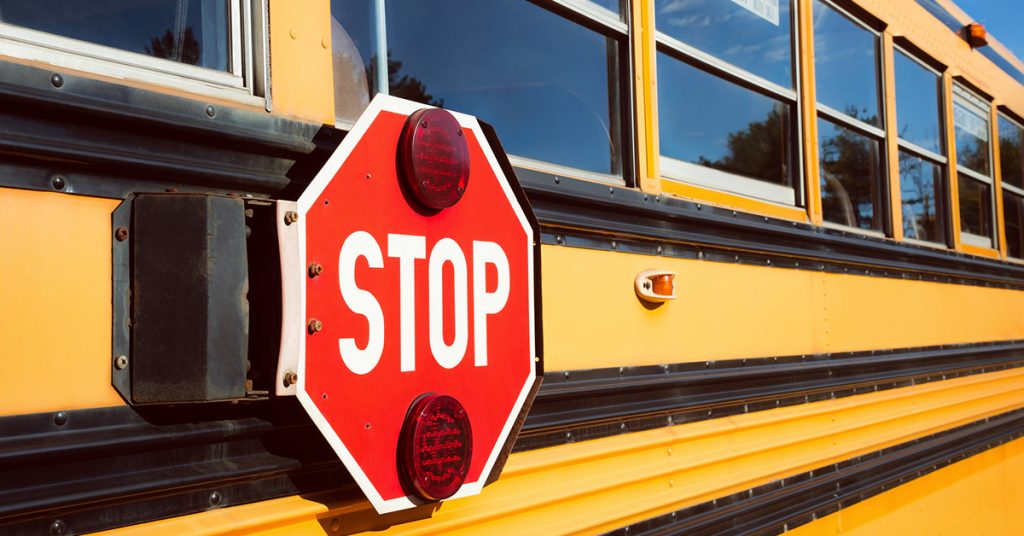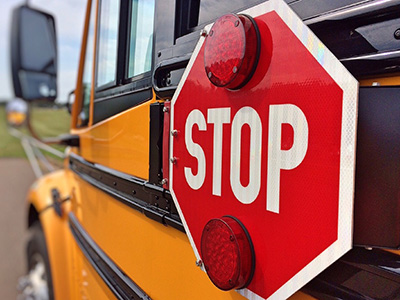Bus Accidents
Back to School Bus Safety in Massachusetts

School buses are back on the road in the Boston area. Take time to plan for safety.
As students head back to school, safety is paramount near school buses. Breakstone, White & Gluck offers reminders to help parents and drivers make safe decisions.
Parents: Learn Massachusetts School Bus Safety Laws
School transportation offices offer a wealth of information, including on safety procedures, safety laws and bus routes. Read the materials your school transportation office sends you promptly. Save the office phone number in your cell phone contacts.
You can also learn by asking your child what they learn. In Massachusetts, students are required to receive classroom instruction on safe riding practices at least three times each school year, under M.G.L. c. 90, § 7B. School districts are also required to conduct twice a year on-bus emergency evacuation drills. You can learn more from the School Health Services website.
The Risk for School Bus Accidents and Injuries
The National Safety Council reports school buses are the safest way for children to get to school. But still, school bus accidents are reported each year.
In 2019, there were 109 fatalities and 13,000 injuries in school bus-related accidents across the U.S., according to the National Safety Council data tabulations. School bus passengers suffered about 6 percent of deaths and 34 percent of injuries in school bus-related accidents between 2010 and 2019. Drivers and passengers in other vehicles suffered nearly 70 percent of the deaths and 53 percent of the injuries. Pedestrians accounted for 17 percent of all deaths.
One important insight: Two-thirds of all children killed in school bus-related fatalities are outside the vehicle at the time, according to the National Safety Council. This means the steps we all take to help students get on and off the school bus safely are critical.
School districts and bus companies have a responsibility to hire school bus drivers who are licensed, trained and have safe driving records. In addition, they have a duty to maintain the mechanical operations and keep a work log. Meanwhile, other drivers on the road have a responsibility to use caution and follow safety laws near school buses. Drivers who take this responsibility seriously can make the drive easier and safer for school children, bus drivers and others on the road.
- As a parent, learn as much as you can about school bus safety procedures from your school.
- Ask about training requirements, criminal and sexual offender registry checks and physical exams drivers must undergo.
- Support and reinforce what your child learns at school and from the bus driver.
- Take a ride on the school bus with your child if you have the chance.
- Notice your child’s bus driver must wear a seat belt. Your child’s school district may or may not have installed seat belts for children. They are not required by state law. School districts can install them following federal safety standards.
- Seat belts are, however, required in other school transportation vehicles, including vans and vehicles carrying 8 or fewer passengers.
- Join your child at the school bus stop. Help them learn how to get on and off the school bus safely.
- Read permission slips and ask questions before you allow your child to ride the bus for sporting events and field trips. Ask if the school district will provide the bus and bus driver, or if a private company has been contracted. Ask for emergency contact numbers and procedures specific to the trip, should the bus be delayed or if there is a safety issue.
Teaching Children How to Get On and Off a School Bus Safely
Getting On a School Bus Safely
For a young child, the sight of a school bus can be exciting and over stimulating.Walk your child through the steps of safety. Teach them to recognize the difference between yellow and red.
Explain that the school bus will approach and flash its yellow lights as it slows down, but that your child should not move toward the bus yet. This is a good time for your child to pick up their backpack and stand at least 10 feet back from the road.
Your child should wait for the school bus to reach a full stop, flash its red lights and extend the stop sign. The bus driver will open the door, make eye contact with your child and let them know they can board the bus.
Exit a School Bus Safely
When stepping off the bus, your child should cross the street in front of the school bus, never behind. Your child should step off the road and onto the sidewalk right away. Let your child know if they leave any belongings on the school bus, you can call the school transportation office later.It is not safe to turn back because school bus drivers and other drivers are not expecting this. While school bus drivers are supposed to check mirrors before moving ahead with their route, there is a very real risk they will not see your child. The greater risk is other drivers may become impatient and start to move toward your child before the bus has stopped flashing its safety lights.
Other Drivers Should Keep a Safe Distance From School Buses
Other drivers have a responsibility to travel safely near school buses and follow traffic laws. This starts with traveling at slower speeds and being prepared to stop.
In Massachusetts, “no person shall operate a motor vehicle within a distance of 100 feet behind a school bus,” per M.G.L. c. 90, § 14. Drivers must also reach a full stop for school buses that have stopped and activated signals to let children on or off. Drivers must remain stopped until the school bus pulls back its stop sign and starts moving again.
Never pass a school bus that has stopped and is flashing its lights. You can cause a very serious accident involving a school bus or another vehicle. Drivers who violate this law can expect a $250 fine for the first offense if they are caught by police or if the school bus driver reports their license plate, M.G.L. c. 90, § 14. Repeat offenders can face additional fines up to $2,000 and license suspensions – all for making a reckless decision stemming from impatience. This is a decision you will only regret later, especially if you cause someone injury and face a civil lawsuit seeking financial damages.
These are simple laws. But many drivers follow school buses more closely than they realize. Next time, try leaving a little more room. You will give the school bus driver more time and open up your own view of the road, helping you to make safer decisions and avoid a collision with the bus or a car accident.
Just as important is safety near school bus stops. Slow down near school bus stops. Never back up your car out of your driveway near a school bus stop. Park your car in a position that allows you to drive out safely in the morning or wait until the bus has come and gone.
While parents and children should stay 10 feet back from the road, there are times when children or pets may step into the road. You have to be prepared to stop – and be patient to avoid an accident.
Distracted Driving Near School Buses
Picking up a cell phone can be a deadly decision near a school bus, where young children and other pedestrians and cyclists may approach your vehicle closely at times. Commit to safety and focus on the roads, not your device, as students head back to school.
The Dangers of School Buses at Intersections
School buses can obstruct a driver’s view at an intersection. Stay back 100 feet or more so you can watch for the school bus as well as pedestrians and cyclists, and avoid a traffic accident.
Remember that pedestrians may approach near sidewalks and crosswalks, but cyclists may travel in the traffic lane or to the right of traffic. If a school bus has stopped in front of you at an intersection, you may not be able to see if a cyclist has stopped next to them until traffic starts to move.
Free Legal Consultation – Boston Personal Injury Lawyers
Breakstone, White & Gluck has more than 100 years combined experience representing those injured by negligence or wrongdoing in Massachusetts. If you have been injured by someone else’s negligence, learn your legal rights. For a free legal consultation, contact the Boston personal injury lawyers of Breakstone, White & Gluck at 800-379-1244 or 617-723-7676 or use our contact form.
Expect Traffic Enforcement As Students Head Back to School in Massachusetts

With students back to school in Massachusetts, local police departments are stressing safety around school buses while stepping up enforcement of drivers who fail to stop for pedestrians in crosswalks.
If a traffic enforcement sting came to your community, how many drivers would be stopped and cited for unsafe driving? Would you be among them?
We ask these questions as students head back to school across Massachusetts, in communities from Boston and Cambridge to Plymouth and Brockton to Worcester and Springfield.
Police departments across the state have set up traffic enforcement over the past few weeks, focusing on drivers who are not stopping for pedestrians in crosswalks and school buses. A few of the communities include New Bedford, Attleboro and South Boston.
In South Boston, the surveillance followed the tragic death of a 2-year-old in a traffic crash. The child was being pushed in a stroller on the sidewalk, when a van and car collided. The van plowed onto the sidewalk, injuring and ultimately killing the young boy. A day after the crash, the Boston Police Department and Massachusetts State Police set up a traffic enforcement initiative focusing on crosswalk enforcement, speeding and other unsafe driving behaviors. Within a few days, officers had issued approximately 500 citations for traffic violations. This is a very telling number, one Massachusetts drivers can’t ignore.
Breakstone, White & Gluck is a Boston law firm which specializes in personal injury, medical malpractice and car accident cases. Our firm is committed to safety for children, giving away over 20,000 bicycle helmets to children in Massachusetts through our Project KidSafe campaign. With experience representing clients who have been injured in pedestrian crosswalk accidents and other traffic crashes, we offer these tips for safe driving:
Slow down at crosswalks. Students who walk to school may have a crossing guard help them across the street. Always slow down as you approach crossing guards and children. Make eye contact with the crossing guard and assume you should stop. The crossing guard will wave you through when it’s safe to go.
But even when there is no crossing guard, drivers must stop for pedestrians in the crosswalk when there is a “Walk” or green signal. Other times, drivers have a responsibility to yield the right of way by slowing or stopping for pedestrians in the crosswalk. This includes times when pedestrians are in the crosswalk on the same side as the driver and when pedestrians are approaching from the other half of the lane and within 10 feet. There is a $200 fine for crosswalk violations in Massachusetts.
The best thing to do is approach crosswalks slowly and stop if you see anyone even near the entrance of the crosswalk. If you can, make eye contact with them, then wave for them to go. Depending on whether other cars stop, they may not be able to immediately cross. You may need to be patient for a few moments.
M.G.L. c.89 § 11 is the law governing pedestrian rights in crosswalks in Massachusetts. Read more about the law.
Attorney Marc Breakstone Reaches $1.375 Million Settlement for Pedestrian Struck and Seriously Injured by MBTA Bus
 Attorney Marc Breakstone recently reached a $1.375 million settlement for an elderly man who was hit by an MBTA bus in a pedestrian crash while crossing Dudley Street in Roxbury. The man suffered a traumatic brain injury and bone fractures.
Attorney Marc Breakstone recently reached a $1.375 million settlement for an elderly man who was hit by an MBTA bus in a pedestrian crash while crossing Dudley Street in Roxbury. The man suffered a traumatic brain injury and bone fractures.
The on-board bus video showed the pedestrian bus accident was preventable. The plaintiff was clearly visible to the operator, who did not respond for several seconds. The investigation revealed the bus driver was traveling above the speed limit.
The video also confirmed the bus driver gave a false account to MBTA Police. The driver said the man had run out from behind parked vehicles. But the video showed there were no parked vehicles obstructing the view and the victim was not running.
The case was settled at mediation in May 2016 and later reported in Massachusetts Lawyers Weekly. Read the case report.
Our Experience: One of the Largest Bus Accident Verdicts in Massachusetts
The attorneys of Breakstone, White & Gluck have over 100 years combined experience representing those who have been injured by the negligence of others in car, truck and bus accidents. Bus accident cases are complex and many attorneys do not have experience investigating these cases or representing those who have been injured or killed. But our attorneys have this unique experience; we have handled motor vehicle and bus accident cases from the insurance claims level through trial and appeal.
Many cases can be settled prior to trial, but not every case. In 2008, Attorney Marc Breakstone took a client’s case against the MBTA to Suffolk Superior Court. After a two-week trial, his client was awarded $5.4 million, including interest. It was believed to be one of the largest verdicts ever in Massachusetts for an injury of its kind.
The MBTA filed a motion for a new trial and was denied. It then appealed the case. The state’s Appeals Court affirmed the judgment and the Supreme Judicial Court denied a petition for further review. By the time the MBTA had exhausted its options, the judgment rose to $7.1 million, with interest and medical expenses and lost earning capacity. Read about this case.
About Attorney Marc Breakstone
Marc L. Breakstone has more than 30 years of experience practicing law in Boston. He has been selected as one of the Top 100 Super Lawyers in New England and Top 100 Super Lawyers in Massachusetts. He has also been selected by his peers as one of the top medical malpractice plaintiff’s lawyers in the Super Lawyer balloting. In 2002, Attorney Breakstone was honored as one of ten “Lawyers of the Year” by Massachusetts Lawyers Weekly. More on Marc Breakstone.
Bus Accident Injures More Than 30 Students on Boston Overpass
State Police continue their investigation into last weekend’s bus accident on Soldiers Field Road in Allston, which injured more than 30 passengers.
The Calvary Coach bus, which was carrying approximately 40 students and chaperones from the Philadelphia area, was returning to Pennsylvania Saturday night when the crash occurred. The vehicle reportedly struck the Western Avenue bridge on the road which leads to the Mass Turnpike.
The Boston Fire Department released photos on Twitter showing firefighters standing on the bus and ladders, extricating passengers, some trapped in the vehicle for more than an hour. Several passengers were transported to local hospitals with injuries. At least one 17-year-old remained in critical condition in a Boston hospital on Monday, The Boston Globe reported.
The students were with the Philadelphia area non-profit, Destined for a Dream Foundation, which spent the day visiting Harvard University and Cambridge.
Massachusetts State Police said the bus accident occurred after the driver passed signs posted prohibiting the bus from traveling on that road, which has a 10-foot height limit, according to the Associated Press. State Police are investigating and have not determined whether to file charges or issue a citation against the 66-year-old driver, Samuel J. Jackson. CBS Philadelphia reported that the owner of the company, Ray Talmedge, said Jackson had looked down at his GPS and saw the bridge too late.
Calvary Coach apologized after the bus crash but defended the driver, reported the Boston Herald. The company’s buses have not been involved in a crash in the two years prior to the Boston accident, according to the Federal Motor Carrier Safety Administration. An unidentified driver was written up for unsafe driving.
The state Department of Conservation and Recreation, which maintains Soldiers Field Road, told the Boston Globe it installed rubber signs as a warning for truck drivers. For a period, they also used cowbells to sound an alert, but these were discontinued.
But the Western Avenue bridge never received rubber warning signs, an official with the state agency said. Agency officials told the Boston Herald they would contact GPS navigation companies to ensure the bridge’s height restrictions are recorded.
Related:
Bridge at site of crash lacked height warning, The Boston Globe.
Bus driver may have been distracted by GPS before Soldiers Field Road crash, CBS Boston.
Parents of bus crash victim pray for recovery, Boston Herald.
MassDOT: No plans to raise height of overpass after bus crash, CBS Boston.
Read More



